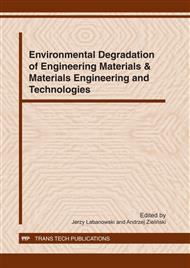p.17
p.25
p.31
p.37
p.43
p.49
p.57
p.65
p.71
Effect of the Ceramic Dispersion in the Nickel Matrix Composite Coatings on Corrosion Properties after Plastic Working
Abstract:
Coatings of metal and ceramic composite were applied on the steel specimens using the subsonic process of flame spraying. The specimens were then subjected to both cold and hot plastic working by rolling and also cold pressing by the hydraulic press. Plastic working is an alternative to machining, as the method of finishing of coats applied by flame spraying. The article presents the findings of the research into the possibility of using plastic working (hot and cold rolling and pressing) to obtain the corrosion properties of the flame sprayed Ni-Al alloy coatings and Ni-Al-Al2O3 composite coatings. The alloy coatings had a single-phase structure, of the maximum 10% aluminium solubility in the crystal lattice of nickel, whereas in the composite coatings the volume content of non-metallic material Al2O3 was 15% and 30 %. After finishing the adhesion reduction, cracks on the surface and cross-sections of coatings was not observed. The largest value of strain hardening of alloy coating Ni-5%Al was stated after pressing. The composite coatings obtain by flame spraying be characterized by big surface roughness (Ra = 13.3 µm). The plastic working caused decrease surface roughness. Minimum value of Ra parameter was observed after hot rolling. It was found that maximal roughness was presented after pressing. The corrosion tests were performed in 0.01 M H2SO4 solution by potentiokinetic technique. The article presents the effect of dispersion phase of Al2O3 on corrosion properties of composite coatings on the nickel base. The corrosion rate was dependent on method of plastic working. The increasing drafts resulted in rise corrosion current density and decrease in value of corrosion potential.
Info:
Periodical:
Pages:
43-48
Citation:
Online since:
December 2011
Authors:
Keywords:
Price:
Сopyright:
© 2012 Trans Tech Publications Ltd. All Rights Reserved
Share:
Citation:


